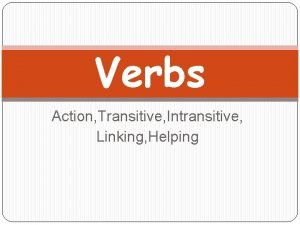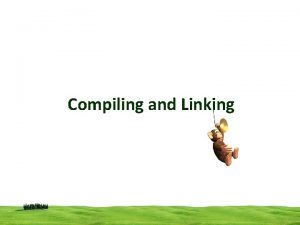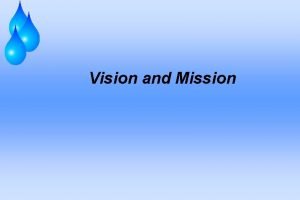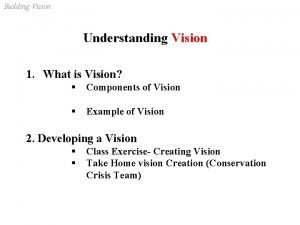Chapter 9 Linking Vision and Change Mc GrawHillIrwin



















- Slides: 19

Chapter 9 Linking Vision and Change Mc. Graw-Hill/Irwin Copyright © 2009 by The Mc. Graw-Hill Companies, Inc. All rights reserved.

Vision Images of Managing Change Content of Meaningful Vision How Context Affects Vision Processes by which Vision Emerges Failure of Vision Debates linking Vision and Change Heroic Leaders or Organizations • Having a vision is often linked to why successful organizational change is achieved • Conversely, lack of vision is frequently associated with organizational decline • The role of vision in producing organizational change is linked to the image one has of managing change • Vision is commonly thought of as a guide for the organization in identifying the appropriateness of particular changes that are proposed 9 -2

Images of Managing Change Vision Images of Managing Change Images Link Vision and Change Navigator Vision is important but not necessarily able to be achieved because of competing visions that exist among various organizational parties and stakeholders. Vision drives change. Coach Vision is something that is important and is more likely to emerge through the facilitation skills of the change leader interacting with his or her followers, shaping their agendas and desired futures. Managers may need to navigate competing visions Nurturer Vision is emergent from the clash of chaotic and unpredictable change forces. Visions are likely to be temporary and always in the process of being rewritten. Vision must relate to environment. Content of Meaningful Vision How Context Affects Vision Processes by which Vision Emerges Failure of Vision Debates linking Vision and Change Heroic Leaders or Organizations 9 -3

Content of Meaningful Vision Images of Managing Change Content of Meaningful Vision How Context Affects Vision Processes by which Vision Emerges • The content of meaningful vision has sparked considerable debate. Some consideration has been given to attributes, its style, and how it is differentiated from mission and organizational values. Here are some examples: – Attributes of vision: • cognitive component – focusing on achieving outcomes • affective component – helping to motivate people and increase commitment to the change (Boal & Hooijberg, 2001) Failure of Vision Debates linking Vision and Change Heroic Leaders or Organizations 9 -4

Content of Meaningful Visions • Four generic characteristics of vision are: – Possibility – for improvement of the organization – Desirability – how it draws upon existing values – Actionability – what actions people can take that can be considered in line with this vision – Articulation - contains imagery that is powerful enough to communicate a clear picture – (Nutt & Backoff, 1997)

Content of Meaningful Visions • Three components of vision are: – Why the change is needed – The aim of the change – The change actions that will be taken – (Pendlebury et al, 1998)

Content of Meaningful Vision Images of Managing Change Content of Meaningful Vision • Vision as stories – This allows a vivid description of the change to which people can relate. Stories are more effective than simple vision statements because people can imagine themselves and their actions in the future. How Context Affects Vision Processes by which Vision Emerges Failure of Vision Debates linking Vision and Change Heroic Leaders or Organizations 9 -7

Beyond Bumper Sticker Visions?

Relationship to Mission, Goals, Strategy • Relationship to mission and goals – Vision is often confused with other terms such as mission statements, goals and values – Whereas vision usually paints a picture of the future and is inspirational, mission statements are more purposive and instrumental in outlining what needs to be done. • Relationship of Vision to Market Strategy: – It has been argued that having a well-specified market vision such as this helps to identify how the company will grow and compete.

How Context affects Vision • There are four organizational contexts in terms of their ability to produce visionary change that should be considered. These are: – Rigid organizations • Small resources, lack of need for change – Bold organizations • Low resources, high acceptance for need to change – Overmanaged organizations • High resources, no need to change – Liberated organizations • High resources, high acceptance for need to change 9 -10

How Context Affects Vision • A vision will “take” in an organization depending on whethere is a contextual “trigger” that alerts people to the need for a new vision. – – Economic Turbulence New Technology

Processes by which vision emerges Vision Images of Managing Change Content of Meaningful Vision How Context Affects Vision Processes by which Vision Emerges Failure of Vision Debates linking Vision and Change Heroic Leaders or Organizations • There a number of approaches to creating vision which include: – Crafting the vision: this can be either leader-dominated, pump-priming or facilitated – Questions that help to develop a vision: this can be done through an intuitive, analytic or benchmarking approach – Connecting the vision to the organization’s inner voice: this connects the vision to the underlying values and beliefs that are held within the organization. 9 -12

Failure of Vision Images of Managing Change Content of Meaningful Vision How Context Affects Vision Processes by which Vision Emerges Failure of Vision Debates linking Vision and Change Heroic Leaders or Organizations • Visions can fail for a number of reasons including being: – – too specific too vague inadequate too unrealistic (Pendlebury et al. , 1998) • A vision must be able to adapt over time • A dominant vision will be one that outlasts others that may be present within the organization. 9 -13

Debates linking Vision and Change Vision Images of Managing Change Content of Meaningful Vision How Context Affects Vision Processes by which Vision Emerges Failure of Vision Debates linking Vision and Change • There are three key debates that link vision and change. – Does vision drive change or emerge during change? – Does vision help or hinder change? – Is vision an attribute of heroic leaders or of heroic organizations? Heroic Leaders or Organizations 9 -14

Vision Drives Change • Without a vision, changes may seem arbitrary or not needed • Vision produces clarity of goals • Outlines the extent of the change, how dramatic it will be, etc. • “strategic intent” – outlines objectives, etc

Vision Erhmagerdes during Change • May not be easy to articulate at the start • Lack of information by those making the vision • Vision may not be important – Actions and plans important

Vision Helps Change • Five ways in which visions help change (Lipton) – Visionary companies have enhanced perf. – Gives org members a roadmap – Imagery of the future will inspire – Recruitment tool – Decision making aid

Vision Helps Change • Articulates the gap between current and future (Metais) • The gap will be filled by creative means to leverage resources – Flanking – exploiting weakness in comp – Encircling – gaining more control of market – Destabilizing – change the competitive rules

Vision Hinders Change • Purely emotional appeals may neglect necessary practical elements • More future-centric than present-centric • Staff may become disillusioned with “fluffy” visions • Staff may see vision as incompatible with values • Organization may have “fuzzy” boundaries
 Dynamic linking vs static linking
Dynamic linking vs static linking Human vision vs computer vision
Human vision vs computer vision Physical reaction
Physical reaction Absolute change and relative change formula
Absolute change and relative change formula Difference between a chemical and physical change
Difference between a chemical and physical change Supply and demand curve shifts
Supply and demand curve shifts What is a physical change
What is a physical change Rocks change due to temperature and pressure change
Rocks change due to temperature and pressure change Physical change and chemical change venn diagram
Physical change and chemical change venn diagram First and second order change in education
First and second order change in education Action verbs and linking verbs
Action verbs and linking verbs What is a physical change
What is a physical change What is integers in maths
What is integers in maths Quantity supplied vs supply
Quantity supplied vs supply Change your water change your life
Change your water change your life Reactive change is change that
Reactive change is change that Spare change physical versus chemical change
Spare change physical versus chemical change When does a physical change occur study jams
When does a physical change occur study jams An example of a physical change
An example of a physical change Chopping wood is a physical change
Chopping wood is a physical change





































